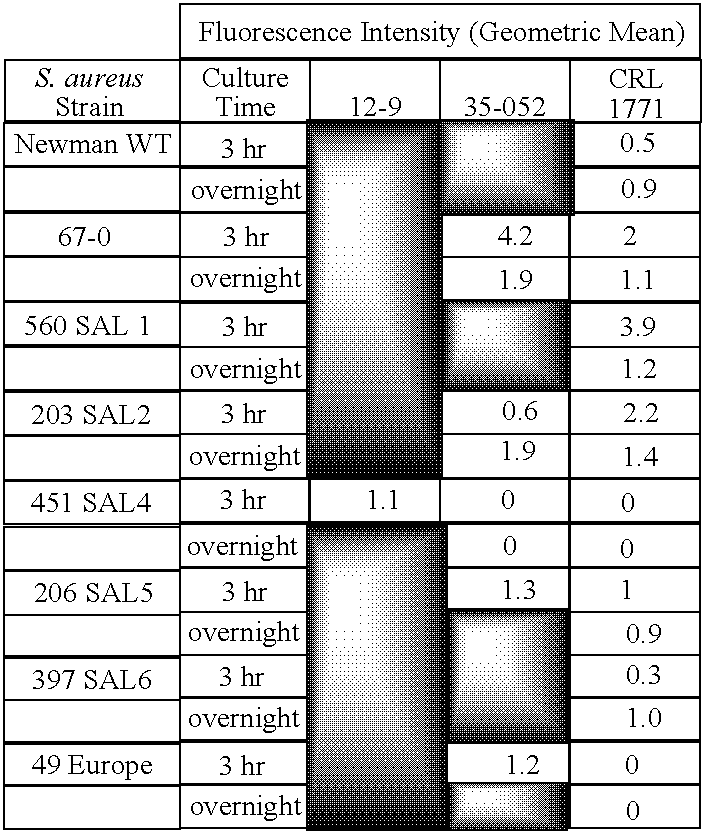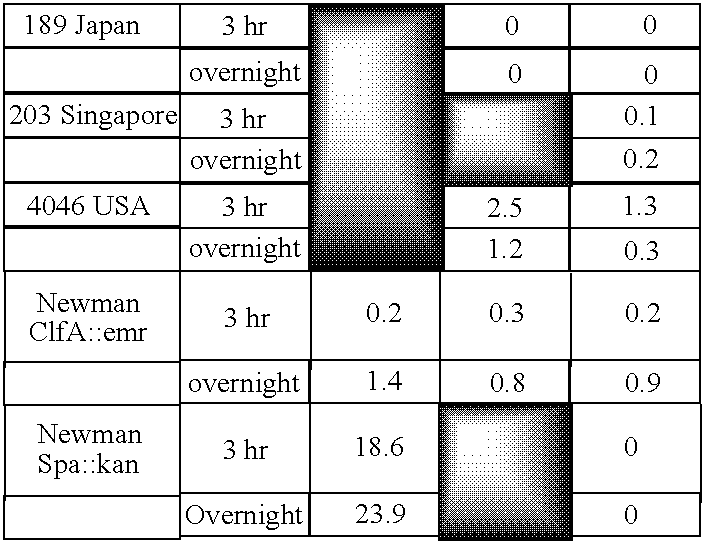Monoclonal antibodies to the ClfA protein and method of use in treating or preventing infections
a technology of monoclonal antibodies and clfa protein, which is applied in the field of monoclonal antibodies to the clfa protein and the method of use in treating or preventing infections, can solve the problems of dramatic alteration of the physiology of the bacteria
- Summary
- Abstract
- Description
- Claims
- Application Information
AI Technical Summary
Benefits of technology
Problems solved by technology
Method used
Image
Examples
example 1
Isolation and Sequencing of Clf40 and Clf33
[0063] Using PCR, the A domain of ClfA (Clf40 representing M 40-559 or Clf33 representing M 221-550) was amplified from S. aureus Newman genomic DNA and subcloned into the E. coli expression vector PQE-30 (Qiagen), which allows for the expression of a recombinant fusion protein containing six histidine residues. This vector was subsequently transformed into the E. Coli strain ATCC 55151, grown in a 15-liter fermentor to an optical density (OD600) of 0.7 and induced with 0.2 mM isopropyl-1-beta-D galactoside (IPTG) for 4 hours. The cells were harvested using an AG Technologies hollow-fiber assembly (pore size of 0.45 μm) and the cell paste frozen at −80° C. Cells were lysed in 1×PBS (10 mL of buffer / 1 g of cell paste) using 2 passes through the French Press @ 1100 psi. Lysed cells were spun down at 17,000 rpm for 30 minutes to remove cell debris. Supernatant was passed over a 5-mL HiTrap Chelating (Pharmacia) column charged with 0.1M NiCl2....
example 2
Monoclonal Antibody Production Using Clf40 and Clf33
[0066] The purified Clf40 or Clf33 protein was used to generate a panel of murine monoclonal antibodies. Briefly, a group of Balb / C mice received a series of subcutaneous immunizations of 50 μg of Clf40 or Clf33 protein in solution or mixed with adjuvant as described below in Table I:
TABLE IInjectionDayAmount (μg)RouteAdjuvantPrimary050SubcutaneousFreund's CompleteBoost #114 5(Clf40)IntravenousPBS10(Clf33)
[0067] Three days after the final boost, the spleens were removed, teased into a single cell suspension and the lymphocytes harvested. The lymphocytes were then fused to a SP2 / 0-Ag14 myeloma cell line (ATCC #1581). Cell fusion, subsequent plating and feeding were performed according to the Production of Monoclonal Antibodies protocol from Current Protocols in Immunology (Chapter 2, Unit 2.).
[0068] Any clones that were generated from the fusion were then screened for specific anti-Clf40 antibody production using a standard ELIS...
example 3
Additional Studies of Clf40 and Clf33
[0072] Using PCR, the A domain of ClfA (Clf40 representing M 40-559, Clf33-N2N3 domain representing AA 221-550 or Clf-N3 domain representing AA370-559) was amplified from S. aureus Newman genomic DNA and subcloned into the E. coli expression vector PQE-30 (Qiagen), which allows for the expression of a recombinant fusion protein containing six histidine residues. This vector was subsequently transformed into the E. coli strain ATCC 55151, grown in a 15-liter fermentor to an optical density (OD600) of 0.7 and induced with 0.2 mM isopropyl-1-beta-D galactoside (IPTG) for 4 hours. The cells were harvested using an AG Technologies hollow-fiber assembly (pore size of 0.45 mm) and the cell paste frozen at −80° C. Cells were lysed in 1×PBS (10 mL of buffer / 1 g of cell paste) using 2 passes through the French Press @ 1100 psi. Lysed cells were spun down at 17,000 rpm for 30 minutes to remove cell debris. Supernatant was passed over a 5-mL HiTrap Chelatin...
PUM
 Login to View More
Login to View More Abstract
Description
Claims
Application Information
 Login to View More
Login to View More - R&D
- Intellectual Property
- Life Sciences
- Materials
- Tech Scout
- Unparalleled Data Quality
- Higher Quality Content
- 60% Fewer Hallucinations
Browse by: Latest US Patents, China's latest patents, Technical Efficacy Thesaurus, Application Domain, Technology Topic, Popular Technical Reports.
© 2025 PatSnap. All rights reserved.Legal|Privacy policy|Modern Slavery Act Transparency Statement|Sitemap|About US| Contact US: help@patsnap.com



